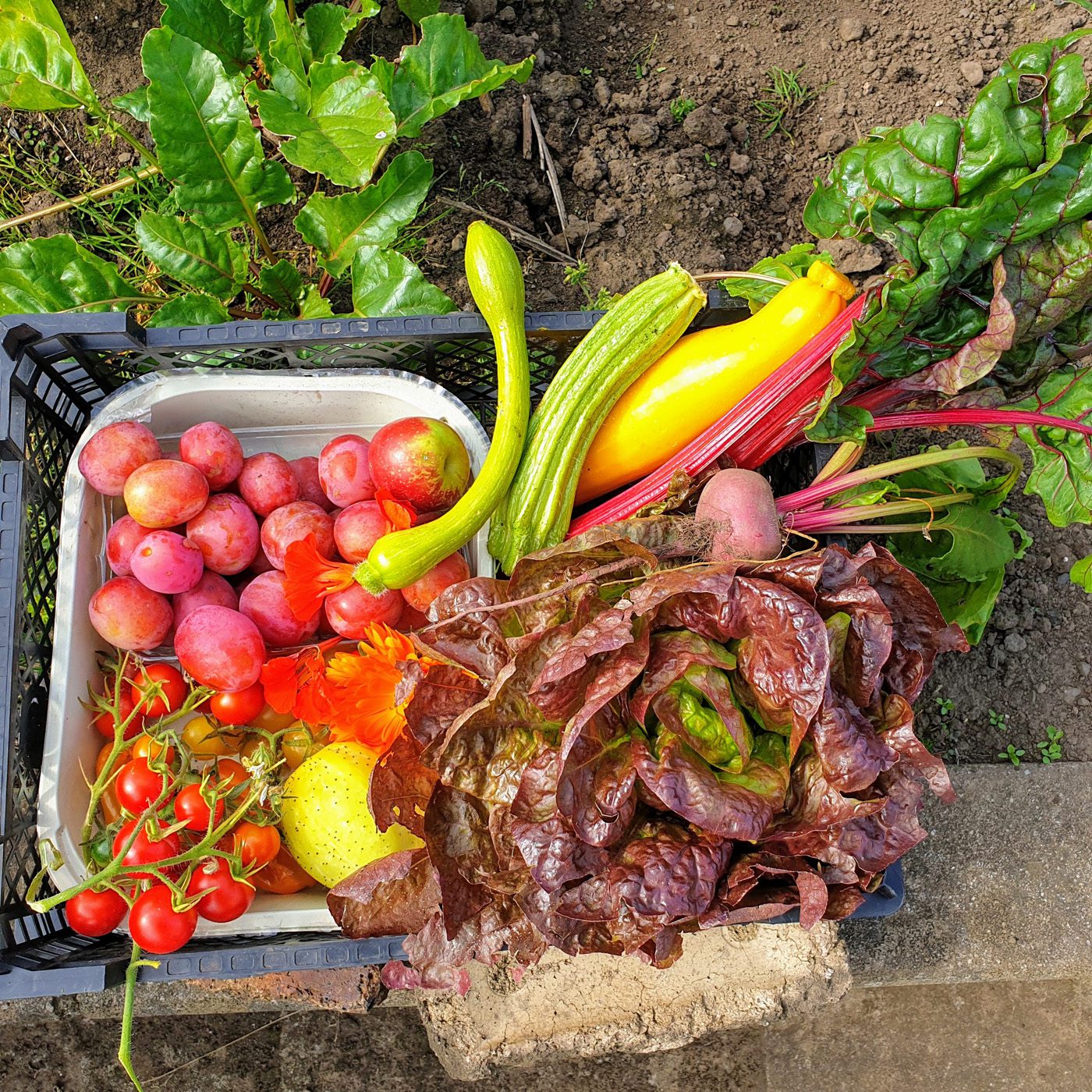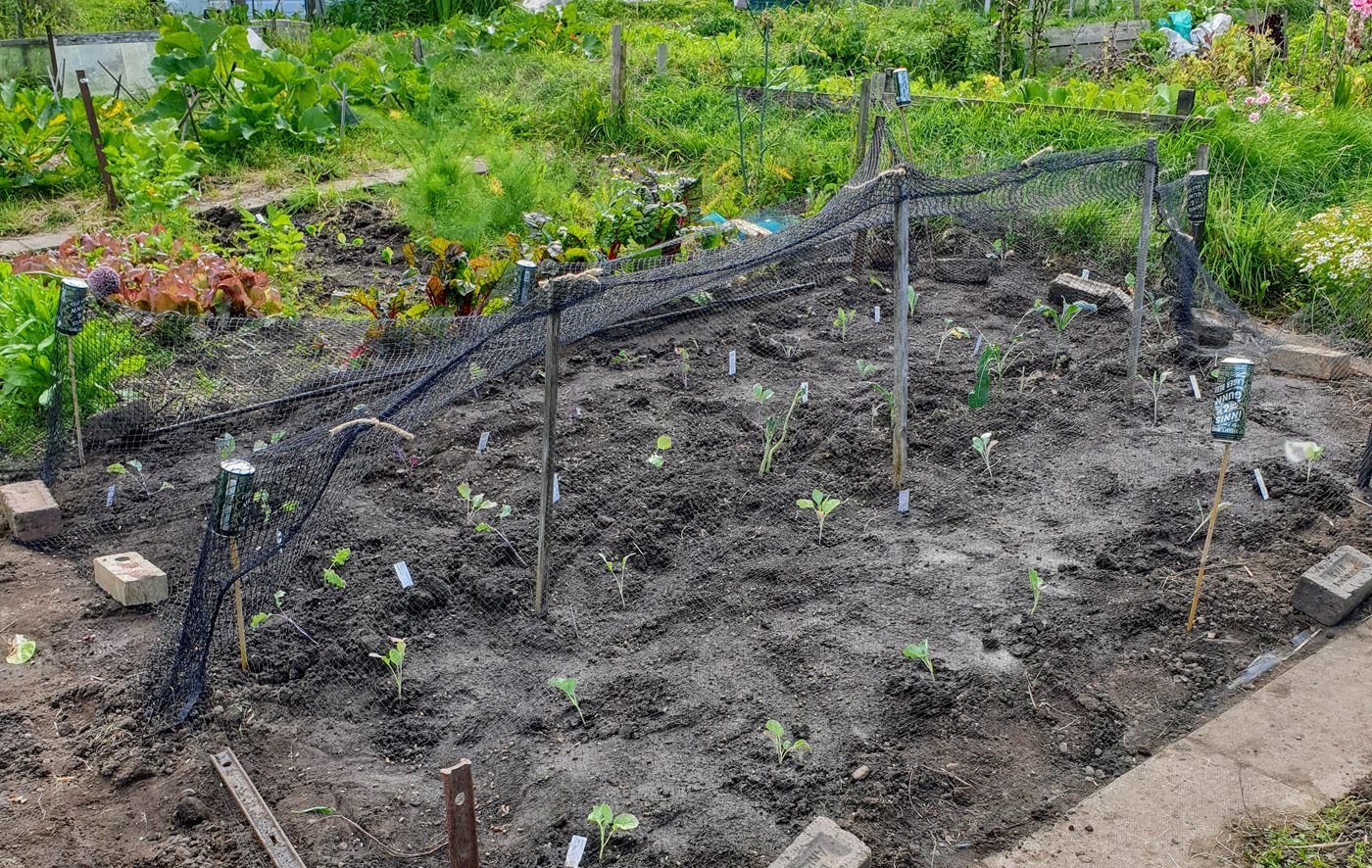What a fantastically productive and colourful month on the plot! With a little help from yours truly, we enjoyed a dramatic display.
It’s like someone twisted the accelerator on the motorbike of growth and everything is speeding along at 90 miles an hour in a highly illegal fashion.
What were tiny stalks of green in April are now 5-foot sticks of corn festooned with ripening ears.
Tiny seeds, barely visible in May, are now full-sized deep-red lettuces, nestling shoulder to shoulder along long rows.
Plums, green and hard in June, are now purple, dripping with juice and sweet as syrup.

Despite basking in the colours of such seasonal fruitfulness, last month I also faced a challenge: I lost my battle with no dig.
Two beds which had hitherto been defiantly undug, fully in line with the “no dig” philosophy, got dug.
This matters because, when I first took on the plot, early last year, no dig was my future. As per the massive clue in the name, it means you don’t dig the ground. This, according to those who do no dig, means less work and time digging but also allows the undisturbed soil to build up its stores of micro- organisms which have a vital if little understood role in helping plants grow well.
I must admit, when I first heard about no dig, they had me at “less work”.
Combining a full-time job with hand-rearing two small people was never likely to leave huge swathes of time to pootle about a glorified garden.
Also, as someone cursed with short legs and long back, I suffer from back pain when I do many things, including washing up (seriously!), so I found the idea of not digging very enticing indeed...
The down side of no dig, hidden away in the small print behind the glossy “less work”, “better food” headlines, is that unless you are content for your plot to resemble a Vietnamese jungle half-way through the growing season, you need to mulch.
And “mulch”, which admittedly sounds lovely, in a hands-on, warm and fuzzy kind of way, means spreading thick layers of organic matter all over the soil to suppress weeds and give the friendly bacteria and earthworms something to incorporate, to create a living, nurturing blanket. Like chocolate spread on toast, you don’t want to see the toast.
You spread thick.
Which is all fine until you crunch the numbers and reveal that to effectively mulch a full-size allotment you need something like seven tonnes of mulch material every single year.
At current conversion rates, to use a unit of measure most of us can relate to, this is “blooming expensive”. It must also be carried from the allotment gate to the plot, barrow by barrow, spade by spade. Which means work!
To dig, or not to dig, as it turns out, is an irrelevant question – both involve plenty of work.
But, before Charles Dowding (king of no dig) and his cohorts flood the already overflowing comments section at the bottom of this piece (irony), let me make clear: I fully appreciate that dug ground also requires organic matter.
There is no substitute for good compost in any growing system, at any scale.
And the compost I produce on the plot from the surplus growth, leafy weeds (not the seeds!), cuttings, trimmings and old plants, does go some way to providing this.
But it isn’t enough, so around two tonnes will always need to be brought in and incorporated at key moments, alongside judicious use of weed membrane to pause some of the beds during their dormant periods.
In the spirit of full disclosure, there is another reason for the two dug beds: My Dad.
My Dad grew many things when I was growing up, in the garden of a very old house in a semi-rural village surrounded by agricultural fenland.
I watched as he transformed our long, thin strip into row upon row of veg beds which, in turn, produced all manner of homegrown goodies for our evening meals, cooked by my Mum. At the time, I overlooked this synchronicity but, looking back, it was impressive.
When I think back to watching my Dad dig on long summer evenings, putting serious amounts of effort into turning soil, I feel a sense of nostalgia.
I am taken back to warm air; seeing armfuls of produce reach the kitchen; hearing radio 4 (always the Archers); my Mum marinating a piece of meat with whole spices that should not be eaten from a Madhur Jaffrey recipe book; a cat snoozing somewhere; me or my brother setting the table; candles lit; eating; laughing.
And so it was, during one of my more reflective periods this August, more than 30 years later, I turned to Dad and asked for his help on my plot. A weird feeling, especially as I usually prefer to fail alone – it is not something I share lightly.
My request was in recognition of two things: one, I am struggling to maintain the plot in the manner I would like with the meagre amount of spare time I have available and, two, I feel the pull of time and would like to regain that connection we held between us where I sat, watched and occasionally interfered as the impressive, slightly mysterious figure of my Father worked his patch of land.
And so it came to pass. He dug two beds and into them I planted brassica and strawberries.
In the coming months and years, I hope we will dig more together, and choose what to grow where together and weed together and quite possibly discuss the merits of various approaches to growing food together over a beer or two in the cool, clean Edinburgh air.

The Newly dug bed with brassica planted
Perhaps my Mum and my Wife will cook some of what we grow and the nostalgic bubble of wholesomeness will be re-imagined with my own children, who would frankly rather watch YouTube Kids.
Either way, keeping the plot just got a whole lot deeper.
Keeping the plot: A journal of growing and cooking Scottish produce – July 2019